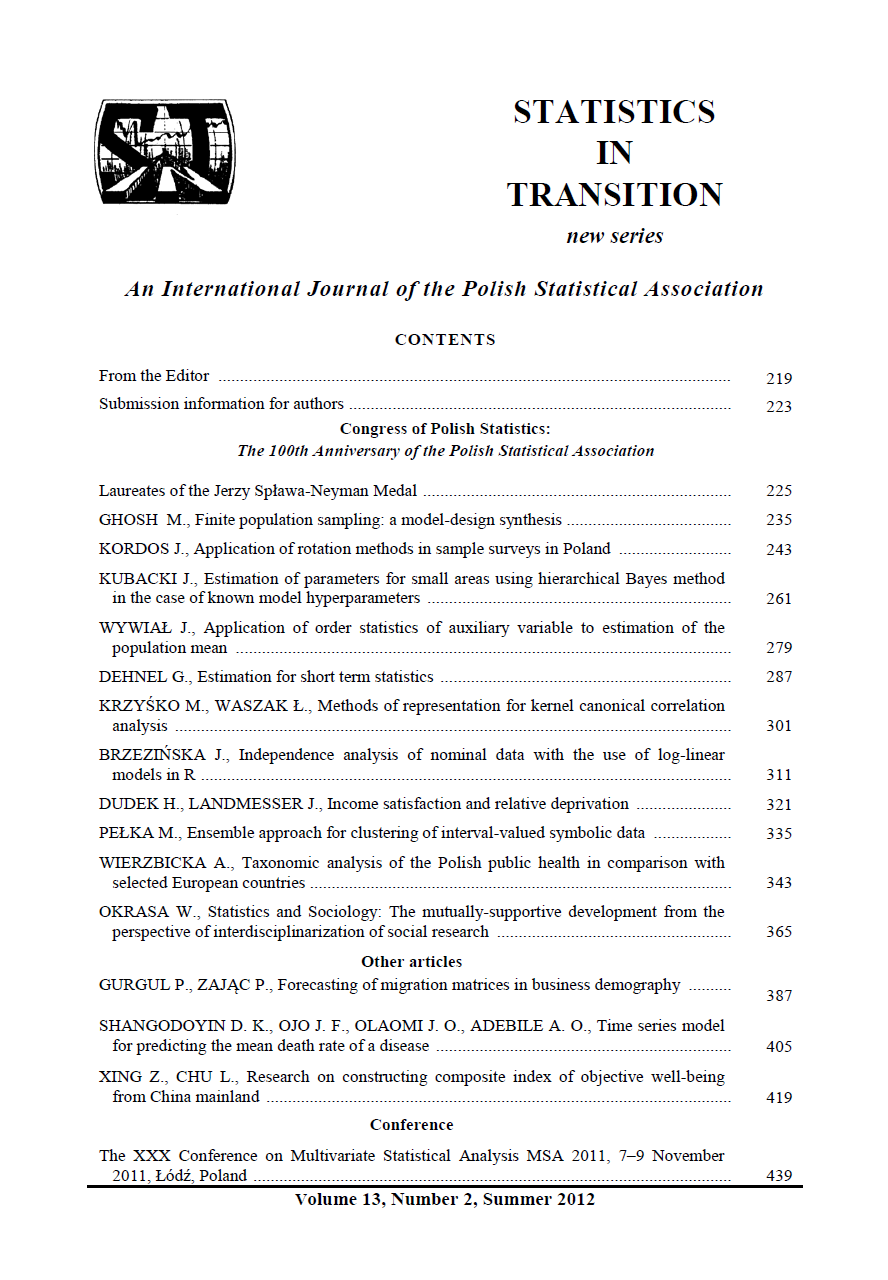ARTICLE
ABSTRACT
This study develops a time series model to estimate the mean death rate of either an emerging disease or re-emerging disease with a bilinear induced model. The estimated death rate converges rapidly to the true parameter value for a given mean death at time t. The derived model could be used in predicting the m-step future death rate value of a given disease. We illustrated the new concept with real life data.
KEYWORDS
Mean death, bilinear model, Death cases, emerging and re-emerging diseases.
REFERENCES
AKAIKE, H. (1973). Maximum Likelihood Identification of Gaussian Auto regresssive Moving Average Models. Biometrika 60, 255-265.
ALTMAN, K.L. (2003). The SARS epidemic. The front line research. New York Times. May 07 Edition.
ANDERSON, T.W. (1971). The Statistical Analysis of Time Series, New York and London Wiley.
BUCHWALD, P. (2007). A general bilinear model to describe growth or decline time profiles Math Biosci. 2007 205(1):108-36.
BRUNI, C., DUPILLO, G. and KOCH, G. (1974). Bilinear Systems: An Appealing Class of Nearly Linear System in Theory and Application. IEEE Trans. Auto Control Ac-19, 334-338.
CHEN, C.W.S. (1992). Bayesian Inferences and forecasting in bilinear time series models. Communications in Statistics – Theory and Methods 21(6), 1725-1743.
DONNELLY, C.A., et. al (2003). Epidemiological determinants of spread of causal agent of severe acute respiratory syndrome in Hong Kong. The Lancet, 361,pg 1761-1766.
GRANGER, C.W.J. and ANDERSON, A.P. (1978). Introduction to Bilinear Time Series Models. Vandenhoeck and Puprecht.
GONCLAVES, E., JACOB P. and MENDES-LOPES N. (2000). A decision procedure for bilinear time series based on the Asymptotic Separation. Statistics, 333-348.
HAGGAN, V. and OZAKI, T. (1980). Amplitude Dependent Exponential AR Model Fitting for Non-Linear Random Vibrations. Proc. International Time Series Meeting, Nottinghamm, ed. O. D. Anderson. North Holland.
JONES, D.A. (1978). Non-linear Autoregressive Processes. Proc. Royal Soc. London (A) 360, 71-95.
KINDIG, D.A., SEPLAKI, C.L. and LIBBY, D.L. (2002). Death variation in US subpopulations. Bulletin of WHO, 80(1), pg 9-15.
LI, W.K. and HUI, Y.V. (1983). Estimation of random coefficient autoregressive process: An empirical Bayes approach . Journal of Time Series Analysis, Vol. 4, No. 2. pg 89-94.
LOHMANN, M.S. (2005). Data quality control and observations error estimation. www.ucar.edu.
MARTINS, C.M. (1997). A Note on the Third-Order Moment Structure of a bilinear model with Non-Independent Shocks. Potrugaliae Mathematica vol 56, 58-89.
MATHERS, C.D. and LONCAR, D. (2006). Projections of global mortality and burden of disease from 2002 to 2030. PLos Medicine. Vol. 3. Issue 11, pp 2011-2030.
MOHLER, R.R. (1973). Bilinear Control Processes. New York: Academic Press.
PRIESTELY, M.B. (1978). Non-Linear Models in Time Series Analysis. The Statistician 27, 159-176.
SHANGODOYIN, D.K., OJO, J.F. and KOZAK, M. (2010). Subsetting and identification of optimal models in one-dimensional bilinear time series modelling. International Journal of management science and Engineering management England, UK, 5(4), pp 252-260.
SHANGODOYIN, D.K. (2010). Using time series models to determine the death rate of a given disease. To appear in International Encyclopaedia of Statistical Science (Springer, USA).
SUBBA RAO, T. (1981). On the theory of Bilinear time Series Models ,Jour. R. Statist. Soc.B. 43, 244-255.
TONG, H. AND CHAN, K. (2006). Estimating the death rate of an emerging disease by Time Series Analysis. Technical report, Department of Statistics & Actuarial Science, University of Iowa, Iowa, USA.
TUAN DINH PHAM and LANH TAT TRAN (1981). On the First Order Bilinear Time Series Model. Jour. Appli. Prob. 18, 617-627.
WALKER, A.M. (1962). Large sample estimation of parameters of autoregressive processes with moving average residuals. Biometrika, 49, 117-131
